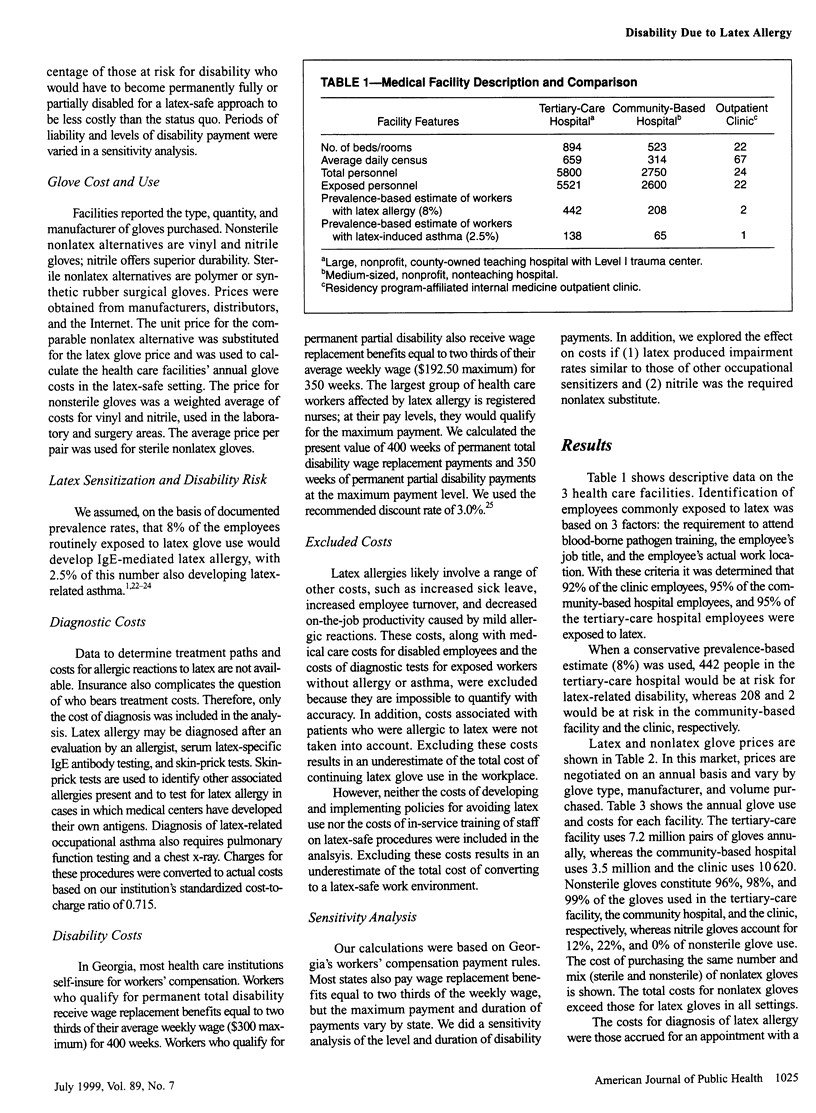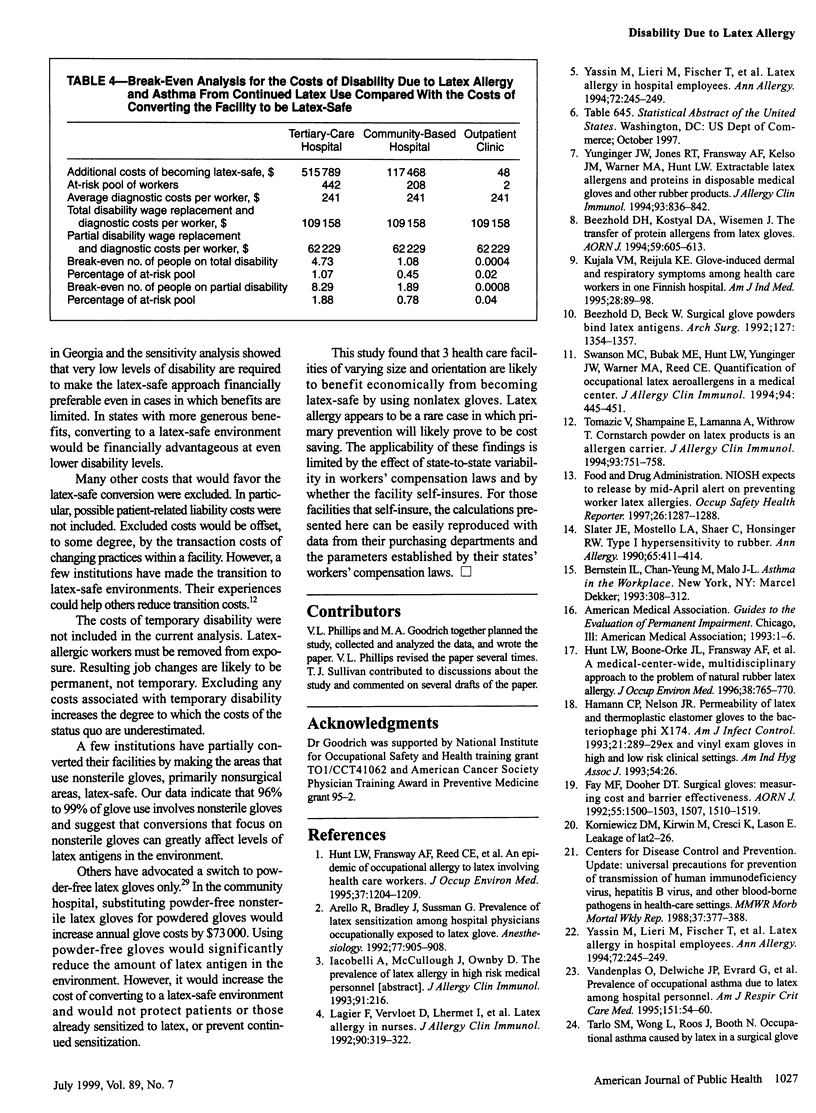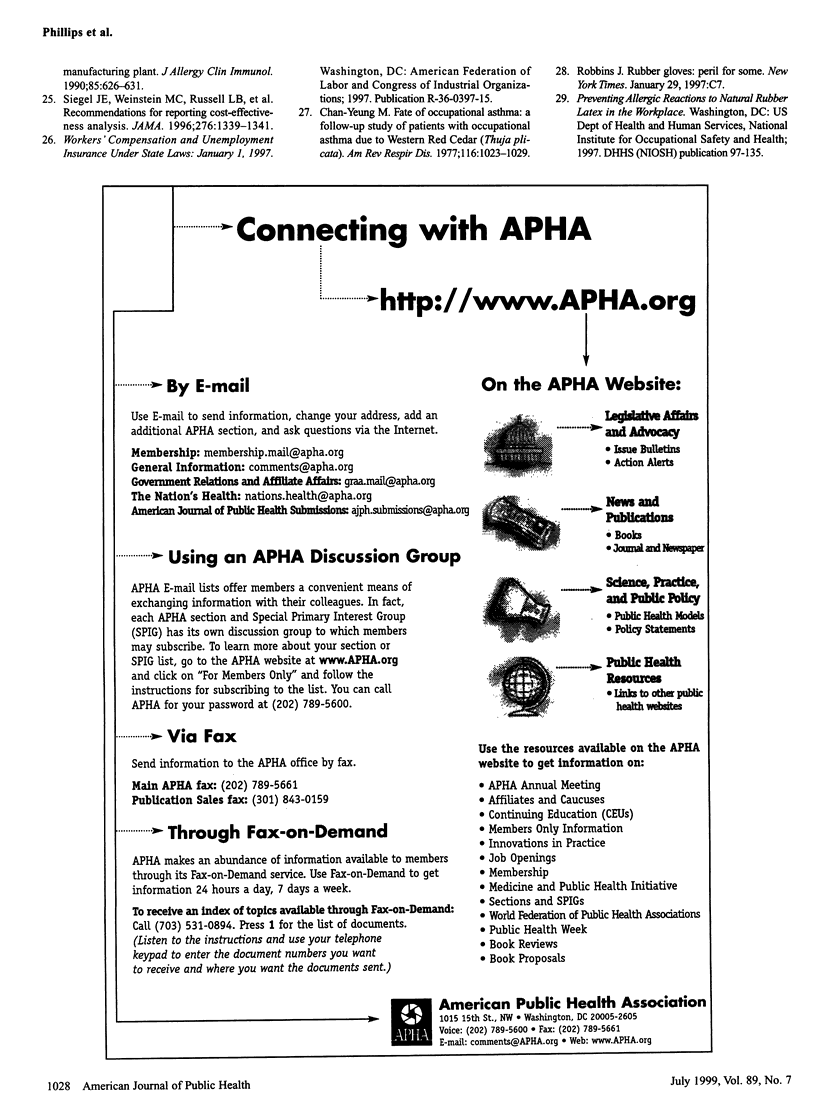Abstract
OBJECTIVES: The reported prevalence of occupational allergy to natural rubber latex is 8% to 17%, and that of latex-induced occupational asthma is 2.5% to 6%. Conversion of medical facilities to "latex-safe" can reduce employee sensitization, impairment, and disability. The purpose of this study was to determine the cost of a latex-safe approach, compared with that of continued latex glove use, and to identify the level of worker disability required to make the latex-safe approach financially preferable to a health care institution. METHODS: The costs of 2 strategies--latex-safe vs the status quo--were calculated from the perspective of 3 health care institutions. A break-even point was calculated for each facility. RESULTS: In all facilities, the cost of using nonlatex gloves exceeded the cost of using latex gloves. In all 3 facilities, however, 1% or fewer of those at risk would have to become fully disabled or fewer than 2% would have to become partially disabled for the continued use of latex gloves to exceed the cost of the latex-safe approach. CONCLUSION: Health care facilities, regardless of size, are likely to benefit financially from becoming latex-safe even if latex-related disability levels are extremely low.
Full text
PDF




Selected References
These references are in PubMed. This may not be the complete list of references from this article.
- Arellano R., Bradley J., Sussman G. Prevalence of latex sensitization among hospital physicians occupationally exposed to latex gloves. Anesthesiology. 1992 Nov;77(5):905–908. doi: 10.1097/00000542-199211000-00011. [DOI] [PubMed] [Google Scholar]
- Beezhold D. H., Kostyal D. A., Wiseman J. The transfer of protein allergens from latex gloves. A study of influencing factors. AORN J. 1994 Mar;59(3):605–613. doi: 10.1016/s0001-2092(07)69975-x. [DOI] [PubMed] [Google Scholar]
- Beezhold D., Beck W. C. Surgical glove powders bind latex antigens. Arch Surg. 1992 Nov;127(11):1354–1357. doi: 10.1001/archsurg.1992.01420110102020. [DOI] [PubMed] [Google Scholar]
- Chan-Yeung M. Fate of occupational asthma. A follow-up study of patients with occupational asthma due to Western Red Cedar (Thuja plicata). Am Rev Respir Dis. 1977 Dec;116(6):1023–1029. doi: 10.1164/arrd.1977.116.6.1023. [DOI] [PubMed] [Google Scholar]
- Fay M. F., Dooher D. T. Surgical gloves. Measuring cost and barrier effectiveness. AORN J. 1992 Jun;55(6):1500-3, 1507, 1510-9. doi: 10.1016/s0001-2092(07)66588-0. [DOI] [PubMed] [Google Scholar]
- Hamann C. P., Nelson J. R. Permeability of latex and thermoplastic elastomer gloves to the bacteriophage phi X174. Am J Infect Control. 1993 Dec;21(6):289–296. doi: 10.1016/0196-6553(93)90385-h. [DOI] [PubMed] [Google Scholar]
- Hunt L. W., Boone-Orke J. L., Fransway A. F., Fremstad C. E., Jones R. T., Swanson M. C., McEvoy M. T., Miller L. K., Majerus E. T., Luker P. A. A medical-center-wide, multidisciplinary approach to the problem of natural rubber latex allergy. J Occup Environ Med. 1996 Aug;38(8):765–770. doi: 10.1097/00043764-199608000-00011. [DOI] [PubMed] [Google Scholar]
- Hunt L. W., Fransway A. F., Reed C. E., Miller L. K., Jones R. T., Swanson M. C., Yunginger J. W. An epidemic of occupational allergy to latex involving health care workers. J Occup Environ Med. 1995 Oct;37(10):1204–1209. doi: 10.1097/00043764-199510000-00011. [DOI] [PubMed] [Google Scholar]
- Kujala V. M., Reijula K. E. Glove-induced dermal and respiratory symptoms among health care workers in one Finnish hospital. Am J Ind Med. 1995 Jul;28(1):89–98. doi: 10.1002/ajim.4700280108. [DOI] [PubMed] [Google Scholar]
- Lagier F., Vervloet D., Lhermet I., Poyen D., Charpin D. Prevalence of latex allergy in operating room nurses. J Allergy Clin Immunol. 1992 Sep;90(3 Pt 1):319–322. doi: 10.1016/s0091-6749(05)80009-0. [DOI] [PubMed] [Google Scholar]
- Siegel J. E., Weinstein M. C., Russell L. B., Gold M. R. Recommendations for reporting cost-effectiveness analyses. Panel on Cost-Effectiveness in Health and Medicine. JAMA. 1996 Oct 23;276(16):1339–1341. doi: 10.1001/jama.276.16.1339. [DOI] [PubMed] [Google Scholar]
- Slater J. E., Mostello L. A., Shaer C., Honsinger R. W. Type I hypersensitivity to rubber. Ann Allergy. 1990 Nov;65(5):411–414. [PubMed] [Google Scholar]
- Swanson M. C., Bubak M. E., Hunt L. W., Yunginger J. W., Warner M. A., Reed C. E. Quantification of occupational latex aeroallergens in a medical center. J Allergy Clin Immunol. 1994 Sep;94(3 Pt 1):445–451. doi: 10.1016/0091-6749(94)90199-6. [DOI] [PubMed] [Google Scholar]
- Tomazic V. J., Shampaine E. L., Lamanna A., Withrow T. J., Adkinson N. F., Jr, Hamilton R. G. Cornstarch powder on latex products is an allergen carrier. J Allergy Clin Immunol. 1994 Apr;93(4):751–758. doi: 10.1016/0091-6749(94)90255-0. [DOI] [PubMed] [Google Scholar]
- Vandenplas O., Delwiche J. P., Evrard G., Aimont P., van der Brempt X., Jamart J., Delaunois L. Prevalence of occupational asthma due to latex among hospital personnel. Am J Respir Crit Care Med. 1995 Jan;151(1):54–60. doi: 10.1164/ajrccm.151.1.7812572. [DOI] [PubMed] [Google Scholar]
- Yassin M. S., Lierl M. B., Fischer T. J., O'Brien K., Cross J., Steinmetz C. Latex allergy in hospital employees. Ann Allergy. 1994 Mar;72(3):245–249. [PubMed] [Google Scholar]
- Yassin M. S., Lierl M. B., Fischer T. J., O'Brien K., Cross J., Steinmetz C. Latex allergy in hospital employees. Ann Allergy. 1994 Mar;72(3):245–249. [PubMed] [Google Scholar]
- Yunginger J. W., Jones R. T., Fransway A. F., Kelso J. M., Warner M. A., Hunt L. W. Extractable latex allergens and proteins in disposable medical gloves and other rubber products. J Allergy Clin Immunol. 1994 May;93(5):836–842. doi: 10.1016/0091-6749(94)90374-3. [DOI] [PubMed] [Google Scholar]


